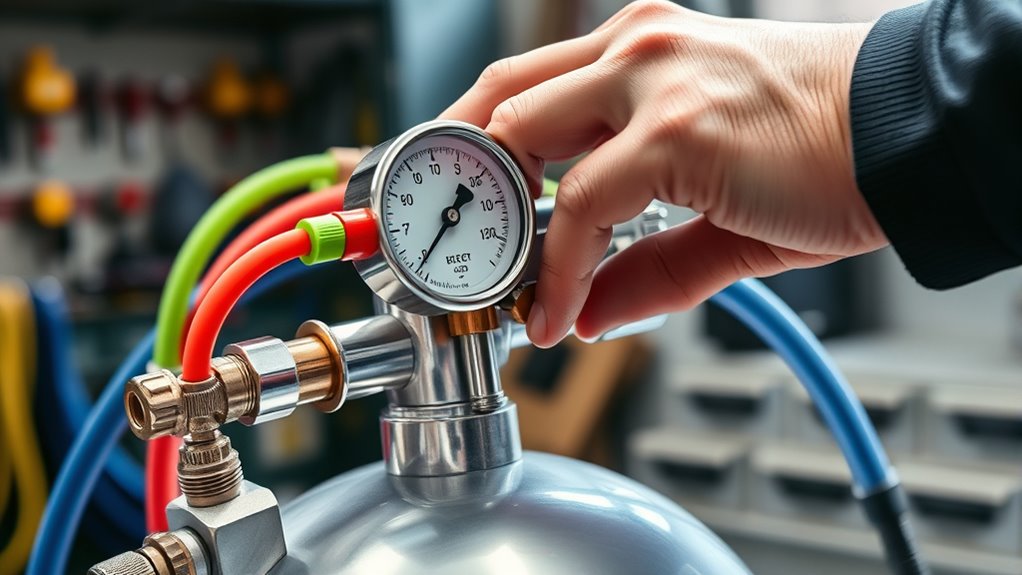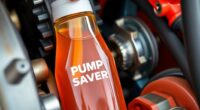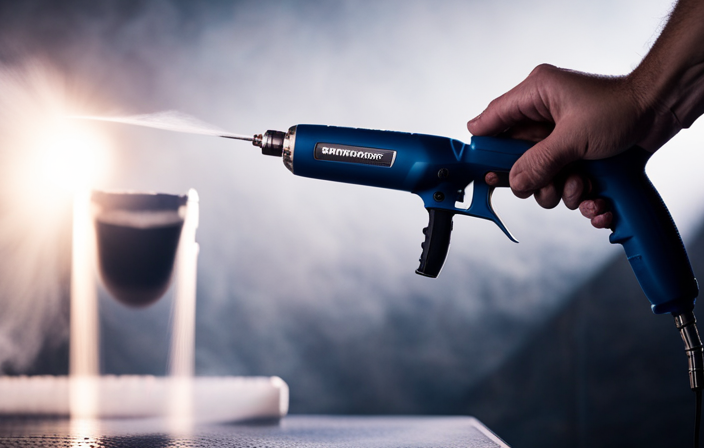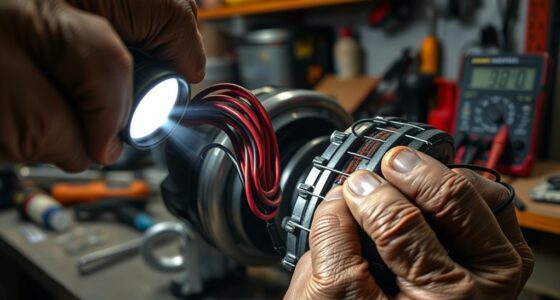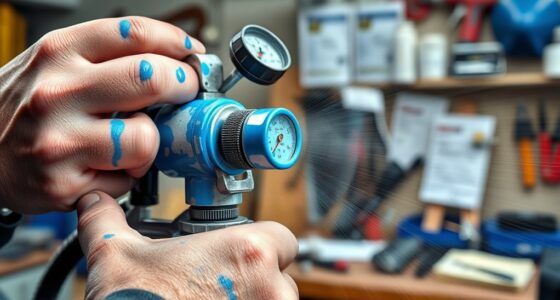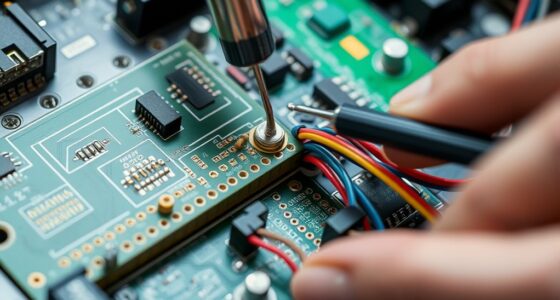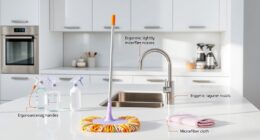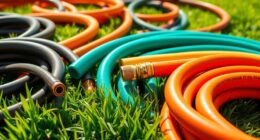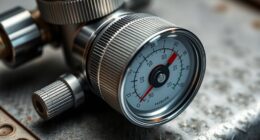To adjust pressure settings for different coatings, start by following the manufacturer’s recommended levels for each product. For thinner paints and stains, lower the pressure to prevent overspray and drips, whereas thicker coatings need higher pressure for proper atomization. Perform test sprays on scrap surfaces, observing the spray pattern for smoothness and consistency. Make small adjustments as needed to achieve even coating and ideal adhesion. Keep exploring to discover tips that help you perfect your spray job every time.
Key Takeaways
- Start with manufacturer-recommended pressure settings for each coating type as a baseline.
- Use test spray patterns on scrap surfaces to evaluate spray quality and adjust pressure accordingly.
- Lower pressure for thin coatings to prevent overspray and drips; higher pressure for thicker, viscous materials.
- Observe spray pattern consistency; uneven or sputtering indicates the need for pressure adjustments.
- Regularly calibrate and double-check pressure settings during application to ensure optimal coating adhesion and finish quality.
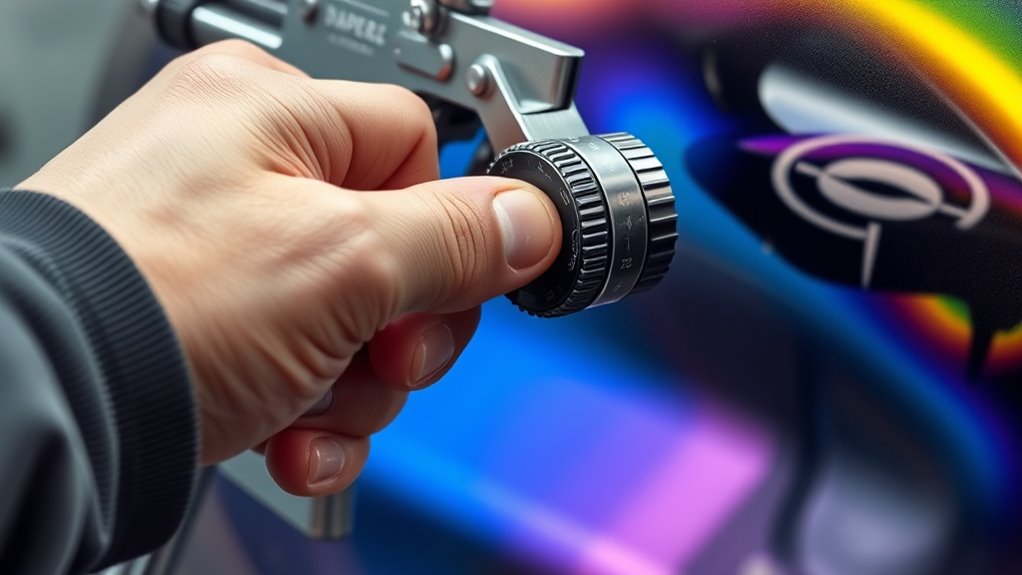
Adjusting pressure settings is an essential step to make certain your equipment functions properly and safely. When working with various coatings, proper pressure control directly influences the quality of the finish and the efficiency of the process. If you don’t calibrate your spray gun correctly, you risk uneven application, poor coating adhesion, and even equipment damage. It’s crucial to understand how to adjust pressure settings to match the specific coating you’re applying, ensuring optimal results every time.
Start by understanding that different coatings require different pressure levels. Thinner paints and stains often need lower pressure to prevent overspray and drips, while thicker or more viscous coatings demand higher pressure for proper atomization. Incorrect pressure can lead to inconsistent spray patterns, causing thin spots or runs that compromise the coating’s adhesion and durability. It’s also important to consider the anti-aging effects of the coating, as the pressure setting can influence the final appearance and longevity of the finish. Always consult the manufacturer’s recommendations for pressure settings tailored to each product, but keep in mind that adjustments may still be necessary based on your equipment and the working conditions.
Different coatings need varying pressure levels for optimal atomization and adhesion.
Achieving the right spray gun calibration is key. Begin by setting your pressure to the recommended level, then perform test sprays onto a scrap surface. Observe the spray pattern—aim for a smooth, even coat without excessive overspray or sputtering. If the pattern appears uneven or the spray is too coarse or too fine, adjust the pressure accordingly. Increasing pressure typically produces finer atomization, which improves coating adhesion by creating a more uniform film. Conversely, reducing pressure can help prevent overspray and ensure better control in tight spaces.
Remember, the goal of adjusting pressure settings is to optimize coating adhesion. Properly atomized paint adheres better to surfaces, resulting in a durable, professional finish. Too much pressure can cause the coating to bounce off the surface or create a rough texture, while too little pressure may lead to poor coverage and weak adhesion. Regularly calibrate your spray gun, especially when switching between different coatings or surfaces, to maintain consistent quality.
Finally, always double-check your pressure settings before starting each new job. Small adjustments can make a significant difference in the final outcome. Proper spray gun calibration, combined with correct pressure adjustments, ensures you apply coatings efficiently and with high quality. By mastering these steps, you’ll improve coating adhesion, reduce waste, and achieve a smooth, professional finish that lasts.
Frequently Asked Questions
How Do Temperature Variations Affect Pressure Adjustments?
Temperature variations directly impact pressure adjustments because they affect temperature stability and coating viscosity. When temperatures fluctuate, coating viscosity can change, requiring you to tweak pressure settings to maintain consistent application. Cooler temperatures increase viscosity, needing higher pressure, while warmer temperatures decrease viscosity, so lower pressure works better. Staying aware of temperature changes helps you fine-tune pressure settings effectively, ensuring your coating process stays smooth and uniform regardless of environmental shifts.
Can Pressure Settings Be Customized for Hybrid Coating Materials?
Think of your spray gun as a musical instrument—you can tune it for different sounds. Yes, pressure customization works for hybrid coatings, allowing you to optimize adhesion and finish quality. By adjusting pressure settings specifically for hybrid coatings, you make certain the material flows smoothly without overspray or defects. Experiment with these settings to find the perfect balance, so your application is flawless and consistent every time.
What Safety Precautions Should Be Taken During Pressure Adjustment?
When adjusting pressure settings, you should always wear safety gear like gloves and eye protection to prevent injuries. Follow proper calibration procedures to guarantee accurate pressure control, avoiding over-pressurization that could cause equipment failure. Check for leaks regularly and work in a well-ventilated area. Never rush the process—careful adjustments help maintain safety and coating quality, minimizing risks during pressure modifications.
How Often Should Pressure Settings Be Recalibrated?
Think of your equipment as a finely tuned orchestra; maintaining pressure stability is key. You should recalibrate your pressure settings at least every six months or whenever you notice fluctuations in performance. Regular calibration frequency guarantees your system stays precise, preventing issues like uneven coatings or equipment strain. By sticking to this schedule, you keep your process smooth and reliable, much like a conductor ensuring every instrument stays in harmony.
Are There Specific Tools Recommended for Fine-Tuning Pressure?
You should use precision tools like digital gauges to fine-tune pressure settings accurately. Digital gauges provide precise readings, making it easier to adjust pressure quickly and correctly. Additionally, calibration tools can help guarantee your pressure regulator stays accurate over time. Regularly using these tools allows you to maintain consistent coating quality, avoid over-application, and ensure your equipment functions at its best. Always choose reliable, high-quality instruments for best results.
Conclusion
Now that you know how to adjust your pressure settings for different coatings, you’re practically a superhero in the coating world! With just a simple tweak, you can conquer any project, avoid disasters, and make your finishes flawless. Don’t underestimate the power of precise pressure—it’s like having a magic wand that turns messy jobs into masterpieces. So go ahead, dial it in perfectly, and watch your coatings transform from mediocre to mind-blowingly magnificent!
